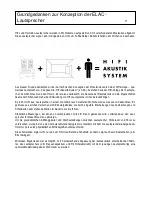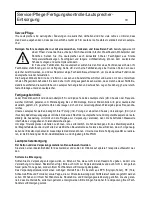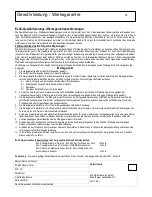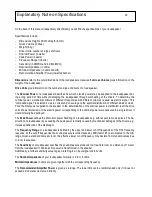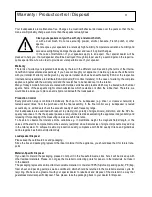
On the back of this manual (respectively attachment) you will find the specifications of your loudspeaker
Specifications include:
-
Dimensions Height x Width x Depth (in mm)
-
Gross Volume (in litres)
-
Weight (in kg)
-
Driver Units: number and type of drivers
-
Nominal Power (in watts)
-
Peak Power (in watts)
-
Frequency Range (in hertz)
-
Sensitivity (in dB/W/m and in dB/2.83Vm)
-
Nominal Impedance (in ohms)
-
Minimum Impedance (in ohms at hertz)
-
Recommended Amplifier Power (in watts/channel)
Dimensions
refer to the outer dimensions of the loudspeakers. Likewise the
Gross Volume
gives information on the
weight of the loudspeaker
Drive Units
give information on the number and type of drivers of a loudspeaker.
The
Nominal Power
of a loudspeaker describes how much electric power may be supplied to the loudspeaker dur-
ing a long period of time without damaging the loudspeaker through overheating of the drivers. To determine the
nominal power, a statistical mixture of different frequencies with different volumes is used as electric signal. This
"composite signal" is selected so as to correspond on average to the spectral distribution of different kinds of music.
Thus the total power supplied to the speaker in the determination of the nominal power is distributed to all the drive
units at a particular ratio. If the electric power corresponding to the nominal power were delivered to a single driver, it
would normally be destroyed.
The
Peak Power
defines the short-time power handling of a loudspeaker e.g. with respect to music pulses. The de-
struction of a loudspeaker by exceeding the peak power is mostly caused by mechanical damages of the drivers, e.g.
increased deflection of the diaphragm.
The
Frequency Range
of a loudspeaker is defined by the upper and lower cut-off frequencies of the SPL frequency
response. At the cut-off frequencies the sound pressure level decreases by 8dB (factor 2.5) as compared to the mid-
range. Given a standard domestic room, the effective lower cut-off frequency may deviate from standard values due
to room resonances.
The
Sensitivity
of a loudspeaker specifies the sound pressure produced in a free-field room at a distance of 1 meter
from the loudspeaker if 1 Watt electric power is ‘transformed’ in the speaker.
Additionally, a further sensitivity value is given referring to an input signal of 2.83 volts.
The
Nominal Impedance
of your loudspeaker normally is 4, 6 or 8 ohms.
Minimal impedances
in ohms are given together with the corresponding frequency
The
Recommended Amplifier Power
is given as a range. The lower limit can be recommended only if it does not
exceed a moderate volume too distinctly.
Explanatory Note on Specifications
30


